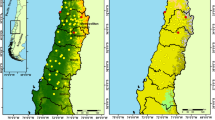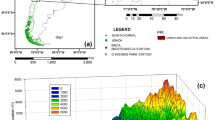Abstract
Ultraviolet radiation (UVR) has long been considered associated with solar dermatitis, but the associations have not been well quantified. To depict the full-range exposure-response association between daily UVR exposures and daily outpatient visits of solar dermatitis. We collected the daily number of outpatient visits of solar dermatitis and monitored hourly ground data of UVR (the sum of A- and B-band) from 1 January 2013 to 31 December 2017 in Shanghai, China. The data were analyzed using the time-series approach, in which overdispersed generalized additive model was used and time trends and weather conditions were controlled for. During the study period, we recorded a total of 15,051 outpatient visits of solar dermatitis. There was a consistently increasing risk of solar dermatitis associated with stronger UVR without a discernible threshold. The effects occurred on the present day, increased to the largest at lag 1 or 2 days, and attenuated to the null at lag 5 days or more. A unit (w/m2) increase in daily maximum-hour UVR was associated with 1.70% (95%CI: 1.19%, 2.20%) increase of outpatient visits of solar dermatitis. Stronger effects occurred among the young people, females, and in the warm season. The risks of solar dermatitis due to UVR exposure would be overestimated if ambient temperature was not adjusted. This study provides quantitative epidemiological estimates for the positive associations between short-term exposure to UVR and increased risks of solar dermatitis. The associations were more prominent among young people, females, and in warm seasons.


Similar content being viewed by others
References
Armstrong BK, Kricker A (2001) The epidemiology of UV induced skin cancer. J Photochem Photobiol B 63:8–18
Bald T, Quast T, Landsberg J, Rogava M, Glodde N, Lopez-Ramos D, Kohlmeyer J, Riesenberg S, van den Boorn-Konijnenberg D, Hömig-Hölzel C, Reuten R, Schadow B, Weighardt H, Wenzel D, Helfrich I, Schadendorf D, Bloch W, Bianchi ME, Lugassy C, Barnhill RL, Koch M, Fleischmann BK, Förster I, Kastenmüller W, Kolanus W, Hölzel M, Gaffal E, Tüting T (2014) Ultraviolet-radiation-induced inflammation promotes angiotropism and metastasis in melanoma. Nature 507:109–113
Balk SJ, Binns HJ, Brumberg HL, Forman JA, Karr CJ, Paulson JA et al (2011) Policy statement-ultraviolet radiation: a Hazard to children and adolescents. Pediatrics 127:588–597
Bernerd F, Marionnet C, Duval C (2012) Solar ultraviolet radiation induces biological alterations in human skin in vitro: relevance of a well-balanced UVA/UVB protection. Indian J Dermatol Venereol Leprol 78:15–23
Bhaskaran K, Gasparrini A, Hajat S, Smeeth L, Armstrong B (2013) Time series regression studies in environmental epidemiology. Int J Epidemiol 42:1187–1195
Buller DB, Cokkinides V, Hall HI, Hartman AM, Saraiya M, Miller E et al (2011) Prevalence of sunburn, sun protection, and indoor tanning behaviors among Americans: review from national surveys and case studies of 3 states. J Am Acad Dermatol 65:S114–S123
Calapre L, Gray ES, Kurdykowski S, David A, Hart P, Descargues P et al (2016) Heat-mediated reduction of apoptosis in UVB-damaged keratinocytes in vitro and in human skin ex vivo. BMC Dermatol 16:6
Chen RJ, Yin P, Wang LJ, Liu C, Niu Y, Wang WD et al (2018) Association between ambient temperature and mortality risk and burden: time series study in 272 main Chinese cities. BMJ 363:k4306. https://doi.org/10.1136/bmj.k4306
Del Bino S, Bernerd F (2013) Variations in skin colour and the biological consequences of ultraviolet radiation exposure. Br J Dermatol 169:33–40
Diffey BL (1991) Solar ultraviolet-radiation effects on biological-systems. Phys Med Biol 36:299–328
Dobbinson S, Wakefield M, Hill D, Girgis A, Aitken JF, Beckmann K, Reeder AI, Herd N, Fairthorne A, Bowles KA (2008) Prevalence and determinants of Australian adolescents' and adults' weekend sun protection and sunburn, summer 2003-2004. J Am Acad Dermatol 59:602–614
Dobbinson S, Wakefield M, Hill D, Girgis A, Aitken JF, Beckmann K, Reeder AI, Herd N, Spittal MJ, Fairthorne A, Bowles KA (2012) Children's sun exposure and sun protection: prevalence in Australia and related parental factors. J Am Acad Dermatol 66:938–947
D'Orazio J, Jarrett S, Amaro-Ortiz A, Scott T (2013) UV radiation and the skin. Int J Mol Sci 14:12222–12248
Engelsen O (2010) The relationship between ultraviolet radiation exposure and vitamin D status. Nutrients 2:482–495
Gasparrini A (2014) Modeling exposure-lag-response associations with distributed lag non-linear models. Stat Med 33:881–899
Ge YH, Liu C, Niu Y, Chen C, Wang WB, Lin ZJ et al (2018) Associations between ambient temperature and daily hospital admissions for rheumatic heart disease in Shanghai, China. Int J Biometeorol 62:2189–2195
Goldman GT, Mulholland JA, Russell AG, Strickland MJ, Klein M, Waller LA et al (2011) Impact of exposure measurement error in air pollution epidemiology: effect of error type in time-series studies. Environ Health 10:61
Grant WB (2016) The role of geographical ecological studies in identifying diseases linked to UVB exposure and/or vitamin D. Dermatoendocrinol 8:e1137400
Hoffmann RT, Schmelz M (1999) Time course of UVA- and UVB-induced inflammation and hyperalgesia in human skin. Eur J Pain 3:131–139
Imai C, Hashizume M (2015) A systematic review of methodology: time series regression analysis for environmental factors and infectious diseases. Trop Med Health 43:1–9
Lan CC, Wu CS, Yu HS (2013) Solar-simulated radiation and heat treatment induced metalloproteinase-1 expression in cultured dermal fibroblasts via distinct pathways: implications on reduction of sun-associated aging. J Dermatol Sci 72:290–295
Marion JW, Lee J, Rosenblum JS, Buckley TJ (2018) Assessment of temperature and ultraviolet radiation effects on sunburn incidence at an inland US Beach: a cohort study. Environ Res 161:479–484
Murphy G, Young AR, Wulf HC, Kulms D, Schwarz T (2001) The molecular determinants of sunburn cell formation. Exp Dermatol 10:155–160
Pinault L, Fioletov V (2017) Sun exposure, sun protection and sunburn among Canadian adults. Health Rep 28:12–19
Pinault L, Bushnik T, Fioletov V, Peters CE, King WD, Tjepkema M (2017) The risk of melanoma associated with ambient summer ultraviolet radiation. Health Rep 28:3–11
Van de Pas CB, Kelly DA, Seed PT, Young AR, Hawk JLM, Walker SL (2004) Ultraviolet-radiation-induced erythema and suppression of contact hypersensitivity responses in patients with polymorphic light eruption. J Invest Dermatol 122:295–299
Yang Y, Chen R, Xu J, Li Q, Xu X, Ha S, Song W, Tan J, Xu F, Kan H (2015) The effects of ambient temperature on outpatient visits for varicella and herpes zoster in Shanghai, China: a time-series study. J Am Acad Dermatol 73:660–665
Yin P, Chen R, Wang L, Meng X, Liu C, Niu Y et al (2017) Ambient ozone pollution and daily mortality: a Nationwide study in 272 Chinese cities. Environ Health Perspect 125:117006
Funding
This study was supported by the National Key Research and Development Program of China (No. 2018YFC1313600) and the National Natural Science Foundation of China (No. 81602757).
Author information
Authors and Affiliations
Corresponding authors
Ethics declarations
Competing interests
The authors declare that they have no competing interests.
Additional information
Publisher’s note
Springer Nature remains neutral with regard to jurisdictional claims in published maps and institutional affiliations.
Rights and permissions
About this article
Cite this article
Zhou, G., Peng, L., Gao, W. et al. The acute effects of ultraviolet radiation exposure on solar dermatitis in Shanghai, China. Int J Biometeorol 64, 585–591 (2020). https://doi.org/10.1007/s00484-019-01845-4
Received:
Revised:
Accepted:
Published:
Issue Date:
DOI: https://doi.org/10.1007/s00484-019-01845-4




